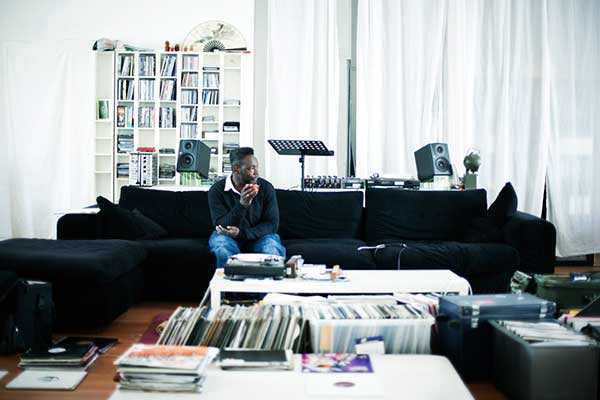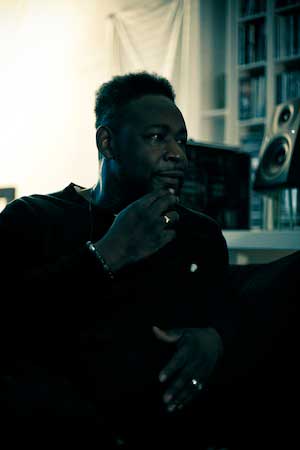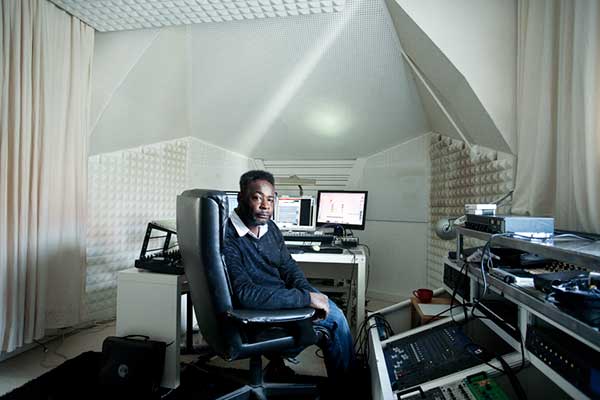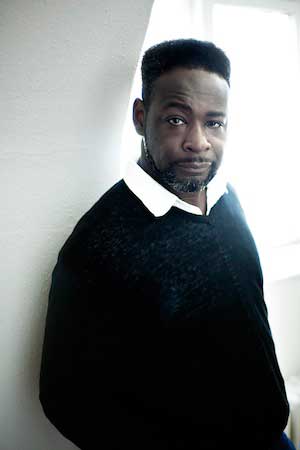| The House that Gerald Built: An interview with A Guy Called Gerald | |
 |
iCrates 21st August 2012 Link |
 More than 2 decades after ‘Voodoo Ray’ laid the brickwork for the pulsating acid house scene in late 80s Manchester, A Guy Called Gerald is still a genius of the underground. And if we were going to talk about the house that Gerald built, we ought to at least visit the house that Gerald lives in. Gerald Simpson is making coffee in his kitchen when we visit him at his Berlin apartment. It’s a domestic scene at odds with the reputation of A Guy Called Gerald - Simpson’s alter-ego - who is credited as being the pioneer of acid house in the early 80s. Since his breakout hit ‘Voodoo Ray’, Simpson has amassed a phalanx of supporters who swear by the Book of Gerald. Self-confessed tech-heads openly admit to having stalked him from continent to continent. So when he asked us if we wanted coffee we said “yes please” and brought along organic chocolate-chip cookies, Norwegian liquorice and half a watermelon. Cause that’s just how we roll. Simpson was kind enough to host us the day after giving us our very own pre-MIDI acid house workshop. Despite the a grand piano, a couple of decks and a drum set and a collection of drums from around the world, the living room we’re shown into retains oodles of space, with a projector beaming the History Channel across the vast front wall of the room. Fittingly, when we asked Simpson if he was sick of doing interviews he replied that, on the contrary, he enjoyed them as it gave him a chance to remember his own story and its place within the history of electronic music. So seated comfortably on the plush black velvet couches, coffee in hand and liquorice firmly in cheek, Simpson began to tell us his story.  It’s a story that began in Moss Side, Manchester. Vast council estates and high levels of unemployment made it an obvious candidate for the riots in the early 80s against government neglect. Given the Dickensian situation of many of its residents you would have expected some equally dark, polemical scene like industrial-electro or “Bleak House”. Instead acid house emerged. And it wasn’t rioting but dance that moved the people. Blow Your House Down Initially, the crowds were mostly of West Indian descent, Gerald recollects, with much of the activity centred around Legend Bar where he would get his first break in 1983. “There was something happening there that I thought was happening all over the UK,” Simpson said, “[b]ut it was very regional. There was lots of small pockets of ‘Dancemania’ happening all over the Northwest of England. We would travel from Manchester to say Preston, Blackpool, to Birmingham even… The focus of everyone’s energy was dance. A lot of us was too young to drink, so that was our buzz… it was a really good way to keep out of trouble.” Keeping out of trouble became a theme in Simpson’s early life in Moss Side. He spent his earlier days in Shena Simon Campus where he showed a keen interest for music often to the neglect of his other subjects. “I had problems in school for anything outside of the creative.” Sport in school being one of his pet hates, Simpson talked in jest about his going AWOL when it came time for gym class. He recalls a story where he even challenged his gym-teacher to a high-stakes arm-wrestle with a winner-avoids-sport outcome. “I used to get the strap, I used to get the hit and I’d do the lines. I’d do anything but [sport]. I’d just be in my own world. I remember when the Walkman was invented and that was it after that. I spent a lot of my time taping the music from my radio to play on my walkman. When I started to realise you could make your own music then I would just go ahead and make it. My early tracks were just for listening on my Walkman.”  After school Simpson would spend time at the kind of home for kids “that you go to where you won’t be any trouble”. The fact that he spoke about the home in a blasé way reflects greatly on how singular his focus was at the time. Simpson’s home, as fluid a concept as it may have been at this stage, was at least taking his mind off his bleaker surroundings. By this stage, he couldn’t arm-wrestle his way out of physical exercise and he was made to take up both dance and boxing. By studying all elements of classical dance, from ballet to contemporary, Simpson found himself pushed to his physical limits. Talking about his time at the Manchester Dance Center and the Royal Northern Ballet he said, “ballet was training every single sinew, every single muscle. That was a way for me to get a bit of discipline for what I wanted to do with my own little thing.” “The boxing training was very easy comparably. It was physical but more an outward physical.” Did his sparring partners razz him about being a ballet dancer? Not a chance, as Gerald’s size at this point had already deterred anyone who was considering giving him a hard time about tutus. He was also quick off the mark in seeing the plus side of being the only man in a troupe of female dancers. “When I went to study at Shena Simon Campus I was the only male. People would be ‘ah you’re doing dance – that’s amazing’. You always need a male counterpart for these ladies and I was there in the class. Got like women in leotards jumping all over me.” The only visible remnant of this early life in Moss Side in Simpson’s current life is the punching bag that obstructs the front entrance of his apartment. But physical mementos aside, what did he take from his time in Manchester? Surprisingly, for much of Simpson’s early life he was kept quite insular from that ‘other’ scene that put the Manchester of Joy Division, The Smiths and New Order on the map. But it was only a matter of time before Simpson found himself in the middle of a barrage of new musical experiences. “Because the city centre of Manchester was so compact and small you could really feed off what was going on there. It wasn’t so hard to find somewhere that was really mixed. And the nucleus of a lot of things was the Haçienda which was literally bang in the centre of Manchester.” “[And] though we had all these different areas around Manchester everyone would get together in the centre. It got to a certain level where if no one’s got any money in their pockets you kind of relate to each other… At the end of the 80s the party scene started to ‘melt’, for want of a better word, into each other.” “The merging of them was pretty invisible.” Simpson continued, “I never realised it was happening. Say like at the Haçienda on the weekend they wouldn’t be playing Joy Division. DJ’s like Graeme Park, Mike Pickering would be playing acid house, stuff from Detroit. And there were a few other places in Manchester that started doing that as acid house started to get more popular.” Among his theories for the unification of the music scenes, Simpson believes that the drugs were the prime reason for this merge. I think that the actual substances that were available at that time made people a little bit more relaxed and feel a little more at ease. Before that they were a little bit scared to let their hair down and dance in their own special way. And Simpson’s own ‘melting’ into the indie scene came when he crossed over into the student world. “That’s when I started to prick my ears up and listen a little bit more…it was like listening to John Peel and how excited he would get about the diversity of things. There was a lot of scope and potential out there and when I was starting to make music I thought that if I just stick in my own channel I’ll just end up chasing my tail.”  Since that time Gerald has lived in London and New York as well as a host of cities around the planet that he’s performed in from Tokyo to Melbourne. As of 2004 he now lives in Berlin. And being something of a nomad Simpson has one very effective way of centering himself in a new city; building himself a studio. For Simpson, a man’s studio is as good as his castle. “I’ve always had my own studio. I signed a deal with Sony and the first thing I did (rather than buying a Porsche and crashing it) was to buy a studio.” “[T]his was what the record companies job was. It was basically to keep the artist on the edge or hungry… They’d be like ‘you need to come in and mix this thing in the studio’ and you couldn’t use your own studio you had to use theirs. And then you’d find you was charged for their studio.” Simpson’s first studio in Berlin nested in the Tacheles arthouse now seems a long way from his current home studio, which although small looks very much like the inside of the Starship Enterprise. There’s an open George Clinton record on the table. He showed us that he was working on his 11th ‘studio’ album, which would be a return to the ‘human voice’ after the instrumental turns he gave in his Berlin session albums. He’s had leading vocalists like Finley Quaye and Ursula Rucker and his new album will include former Goldie-collaborator Diane Charlemagne. Hopefully, it will also be a return to vinyl after having given it a miss for Tronic Jazz (his last album on vinyl was Proto Acid). Proto Acid – The Berlin Sessions Gerald’s own lukewarm views on releasing on vinyl is less a reflection of his views on the medium as they are a reflection of his own high standards. “If you’ve not prepared it in a way that you’re not happy with then I don’t think you should put it out [on vinyl]. And if everyone felt like that it would be a really good self-filter…I’m trying to find a way to do the lushest vinyls possible. I really did hate on it for a long time.” He said, somewhat guilty about his opinion, “I’d like to put out things Voodoo Ray onwards, even 808 State, on a really heavy vinyl but with just one track a side. So it’s just really loud.”  Much of Simpson’s negative reaction to vinyl had were justifiably due to his battles with his former record company. “I felt like I was dragged through the hedge backwards. In the early days a lot of artists wouldn’t really profit from vinyl. You’d put a record out and you’d earn nothing… Say like with Voodoo Ray, it was licensed to Warlock in 1989 or 1990 and they’d pressed up a certain amount. Still they’re pressing them up today. In my hey day I associated all this stuff with record labels. From there I decided to go a little bit more underground. So I did my own label Juicebox and just put my own stuff out from there.” 28 Gun Bad Boy His first full-album under the Juicebox label was 28 Gun Bad Boy, an outstanding drum and bass album straight out of the jungle. And while his earliest courtroom battles may have resembled Jarndyce v. Jarndyce, he still was hopeful for the medium in the future. “If you want to put your own vinyl out there, if you want to sell it on your own website, you can keep tabs on the distributor. If you can manufacture it yourself and have the stock yourself then you’re probably going to be better off. If somebody else is doing the management for you, you’ll probably find that you owe them money.”  Gerald’s views of the future of electronic music range from the advisory to the diatribe. His assessment of the future of his genre, and it is as much his as it is anyone else’s, is frequently bleak. “The whole thing is a kind of competition whereas before it seemed it were more of an art form. Where I was coming from you always wanted the euphoria all the time. You wanted that music to be on all the time. We knew every nuance of the music. In the early days you’d create an arena where people would be dancing and say that there was a track that they knew, you could show how much of a music lover you was if you knew that track.” This disillusion spilled over into Simpson’s recent blog post where he castigated Deadmau5 for demeaning electronic music as a live art. In it, Simpson wrote: “The only button you and people like you are interested in pushing is a nuke for the Palestinians. You come into our system that we have nurtured for the last 25 years, trick hardworking people into giving you their money, con honest promoters, take large sums out of the system and then spit back into our faces that YOU are tricking everyone. I agree there are loads of people like you who do fake it. It is easy with the software you are using. Don’t worry we are going to find ways of stopping you. You greedy rat head fuck.” The remark was posted a week after we had met him and three days later a cavalcade of responses were levelled at the posting. Many found the Palestine remark to be anti-Semitic and many others weighed in support his thoughts. Simpson immediately posted an apology for any offence he may have caused joking that a lack of caffeine may have pushed him over the edge. Deadmau5 kept himself aloof of the matter saying that he considered Gerald to be of no relevance anymore. Web justice is hardly just, but man is it swift.  In the context of Simpson’s career, Deadmau5 will probably have the significance of roadkill but the post does raise the obvious question of which Gerald-the vitriolic or the laidback-is the real one. The truth is probably both or somewhere in between. At the end of it all, Simpson is just a guy called Gerald, entitled to the range of personalities we all traverse. But it is important to note that he is always careful to distinguish how much his fire is reserved for the system rather than the individuals in it; a brother that hates the game far more than he hates the players. After all, he was willing to voice his love for current artists like Carsten Jost, Mathew Johnson and Minilogue. So which Gerald is the real one? A clue to that answer may lie towards the end of our interview when Simpson, highly apologetic that he kept trashing current talent, began to voice some of the more constructive ideas he had on electronic music today. In a post just prior to his Deadmau5 rant, Simpson elucidated some of his principles of the ‘True school’ which was intended to encourage inventiveness in a medium that has no boundaries. After all, if there’s one thing Manchester has been known to inspire, it’s manifestos. “There’s all sorts of different sciences involved in it and I ask myself ‘what would I do to change it’? How could it be changed? Some of the younger people that I’ve tried to work with (not all) tend to have more of a block, square pusher kind of thing where they’re pushing stuff around a computer head. Whereas I actually come from where you build from the ground up.” [Authors: Arjun Harindranath and Mette Muhli] |
|